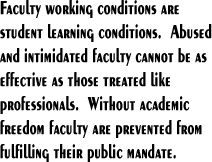1. In a recently published collection
of essays by various hands,
entitled Campus Inc., Michael Parenti
reminds his readers that
the private university is a chartered corporation,
ruled "by a
self-appointed, self-perpetuating board of
trustees composed
overwhelmingly of affluent and conservative
businesspeople." The
class composition of public university governing
boards is
similar. "At no time during their tenure
as trustees," Parenti
continues, "are they troubled by anything
that might be called
democracy."(1)
2. Corporate governance is now a universal
feature of American
higher education. It is capable of
destroying educational
quality and standards; the existence of entire
professional
disciplines; the faculty's responsibility
to serve the best
interests of their profession, their students,
and the public;
and academic freedom.
3. One of numerous examples of administrative
indifference to the
idea of democracy is the recent decision
by the University of
Missouri Board of Curators to adopt the principle
of post-tenure
review. The Board of Curators took
its action despite the solid
opposition of the faculty at UM Columbia,
who defeated the
proposal decisively in two separate votes.
Faculty at UMKC,
meanwhile, were denied the opportunity of
voting, and thus
expressing their views, on this issue.
Ignoring public opinion
or suppressing it altogether has nothing
in common with the
practice of democracy.
4. The issue of post-tenure review is neither
technical nor
trivial. It strikes at the very heart
of higher education.
Post-tenure review belongs to the arsenal
of administrative
weapons intended to weaken and abolish tenure.
Tenure protects
faculty freedom of expression, which is both
a necessity and an
obligation of their profession. Faculty
working conditions are
student learning conditions. Abused
and intimidated faculty
cannot be as effective as those treated like
professionals.
Without academic freedom faculty are prevented
from fulfilling
their public mandate. If faculty can't
teach and research as
they see fit, according to the rigorous standards
of their
profession and their mandate to educate the
next generation,
students are cheated of the quality educational
experience their
tuition, fees, and taxes pay for.
5. Academic freedom pertains to everyone in
academia, not just
faculty. In fact, it covers everyone
in the US, since it derives
from First Amendment rights and was affirmed
as such by the
Supreme Court in 1967. In higher education
academic freedom
includes such things as the teaching and
exercise of critical
thinking; faculty control of and responsibility
for the
curriculum, pedagogy, and the direction of
research; free speech
and inquiry--in the classroom, in research,
on the job, and as
citizen activists; job security, benefits,
and working
conditions; and due process in decision-making.
6. Tenure, or job security, is the main guarantee
of academic
freedom in education. Job security
and first amendment rights on
the job are essential components in democratic
governance. In
the past, American university and college
decision-making was
based on the principles of collegiality and
shared governance,
which assumed a community of interest among
all the members of an
educational institution. AAUP guidelines
on shared governance
were issued in 1966 and adopted by the AAUP,
American Council on
Education, and the Association of Governing
Boards of
Universities and Colleges. They recommend
shared responsibility
and joint planning by students, faculty,
administrators, and the
governing board.
7. The operative principle of shared governance
is delegation of
responsibility. The university administration,
according to AAUP
guidelines, should "concur with the faculty
judgment" in all
"matters where the faculty has primary responsibility."
The
faculty has "primary responsibility" and
"primary authority" for
decisions that bear directly or indirectly
on "curriculum,
subject matter and methods of instruction,
research, faculty
status, and those aspects of life which relate
to the educational
process."(2) Faculty likewise are entitled
to participate
significantly in total institutional budgeting
and allocation of
funds.
8. A national conference last year co-sponsored
by the AAUP and
the American Conference of Academic Deans
reaffirmed the
principles of shared governance. Participants
committed
themselves to working out viable models of
shared governance
based on academic, rather than corporate,
values. Speakers at
the final plenary session emphasized the
unsuitability of a
corporate governance model to institutions
of higher education.
One speaker concluded: "'Applying corporate
models to
universities undermines quality by substituting
quantifiable,
business-driven measures for the judgments
of faculty who have
the expertise to make sound decisions for
higher education.'"(3)
9. The system of shared governance was relatively
successful
because administrators used to come from
the ranks of the faculty
and returned to those ranks when their terms
of service were
over. In addition, boards of trustees,
upper administrators, and
even deans did not make a habit of micro-managing
the everyday
affairs of the university. Instead
they typically followed
faculty advice, as AAUP guidelines recommended.
10. However, in the past several decades a
new class or caste of
academic managers has emerged. Seldom
recruited from tenured
teaching faculty in the same institution,
and rarely returning to
teaching and research, they are typically
selected by outsourced
head-hunting agencies--at a very high price
to the institution,
and therefore to taxpayers--from a pool consisting
primarily of
career managers. Once managers or manager
candidates are chosen
independent of the involvement of the academic
community, they
arbitrarily claim a mandate to make policy.
The faculty are then
expected to reliably carry out orders transmitted
down the
corporate chain of command.
11. Academic CEOs receive astronomical compensation,
often
supplemented by fat fees for serving on corporate
boards.(4)
Even mid-level academic managers, aside from
inflated salaries
two to four times greater than the highest
paid faculty,(5)
frequently derive personal financial benefits
from outside
corporate contracts they negotiate and impose
on their
institutions.
12. In academic institutions taken over by
the nomadic managerial
hordes--particularly in public institutions
with a legal mandate
to serve the people--collegiality and shared
governance have
bitten the dust. Administrators have
adopted an extreme
adversarial position, tearing to shreds and
throwing in the trash
any semblance of a social contract.
13. The corporation is about as undemocratic
a form of governance
as has ever been invented. It resembles
a dictatorship, whether
autocratic or oligarchical. In a corporation
there is no
democratic process--except perhaps for those
at the highest
level. On the job the majority of corporate
employees are
excluded in practice from the right to vote
on institutional
policy, free speech on the job, the rights
to organize and
bargain collectively, a free press voicing
their interests and
dissenting from dictated policy, and free
assembly, due process,
and fair grievance procedures. Token
gestures--for example,
administratively controlled ad hoc planning
committees with
selective input from a limited number of
affected people--are
co-optation techniques meant to project democratic
images without
changing autocratic substance.
14. The broader context of the corporate agenda
is its goal of
eliminating the public domain, which benefits
the vast majority
of people, and to "privatize" (steal) public
institutions,
property, assets, services and natural resources.
One way this
is done is by reducing or eliminating public
funding, and thus
universal public access and democratic oversight.
Reduced public
funding forces educational institutions to
take the bait of
corporate donations. Once hooked, schools
and universities
become tasty snacks at power lunches.
15. The corporate takeover targets education
for the majority of
the people. As in the health care field,
the goal is to
establish a two-tiered system, one for the
rich and the other for
the rest. Elite students will get a
semblance of a decent
education, preparing them to occupy positions
of power and
influence, and elite faculty will generally
continue to be
treated like valued professionals.
The majority of students,
however, will get substandard vocational
training for routinized
dead end jobs. Their jobs will resemble
those in the academic
sweatshop, which is staffed by a decisive
majority of their
teachers, who are graduate students and contingent
labor.
Increasingly the academic sweatshop will
swallow up probationary
faculty and even tenured faculty, who will
be replaced with
contingent labor. Distance learning,
where institutions rather
than faculty own the curriculum, threatens
to reduce full-time
faculty immediately to adjuncts doing overtime
for low pay and no
benefits.
16. The corporate takeover has both economic
and political aims.
The economic one is familiar, to increase
short-term profit by
drastically reducing labor costs, and, in
the case of virtual
education, by eliminating the campus with
its entire physical
plant. The political goal is monopolistic
control of labor and
of public opinion. The mega-corporations
want to subjugate the
professions, like health care(6), journalism,
or education, in
order to destroy professional independence
and self-government,
the standards of performance and service
which they have
developed over centuries, and the very reason
for their
existence, which is to promote knowledge
and skill serving the
general welfare. Thus the professions
are being proletarianized.
17. Like journalism, which has already been
eviscerated by the
media oligopoly,(7) education is specially
targeted in order to
assure corporate ideological control.
Corporations want
ideological dominion over the curriculum,
methods of instruction,
research, fields of study and the directions
in which they
develop, and even the campus environment,
which they deface with
corporate logos, trademarks, and outsourced
monopoly franchises
and concessions, many of which profit by
sweatshop labor.
Monopolistic management of public opinion,
through the mass media
and educational institutions, is obligatory
for corporations to
maintain their power and to deter challeges
from democracy.
18. Democracy not only is about process but
also concerns
outcomes. Examples of democratic outcomes
are equality, justice,
social solidarity, universal abundance, a
strong and healthy
public domain, protection of the biosphere,
universal human
rights--political, social, and economic--and
fair access to and
distribution of products, services, and resources.
Universal
education is a democratic outcome guaranteed
by the UN Universal
Declaration of Human Rights and subsequent
conventions and
covenants.
19. Needless to say, corporate governance
opposes democratic
outcomes. The anti-democratic bias
of corporations derives from
their structure, which assumes the shape
of a pyramidal
hierarchy. The privileging of those
at the top directly depends
on the decreasing privileges and increasing
abuse and
exploitation of those at lower ranks.
20. Democratic outcomes, by contrast, preclude
the existence of
elites or concentrations of wealth and privilege.
In democratic
higher education distinctions in rank are
professional ones,
based on knowledge and accomplishments.
All members of the
community have a voice and a vote on matters
of interest to
them. This is a basic democratic principle:
decision-making
power resides in all individuals affected
by a decision. Since
my specialty is Slavic culture, I was pleased
to find a slogan
from old Polish history (16th and 17th centuries)
that expresses
this basic principle of democracy: "nothing
about us without us
(nic o nas bez nas)." In 16th century
Poland it applied to at
most 8% of the population. In today's
conception of democracy,
it applies to everyone.
21. The fightback against the corporate takeover
depends on
democratic organizing, which is happening
nationwide.
Outstanding examples of effective activism
(two of many) are
provided by the California Faculty Association
(CFA) and
California Part-Time Faculty Association
(CPFA). In 1999 the CFA
held a series of public hearings across the
state to determine a
non-corporate future for public higher education.
In 1997 they
and other faculty, student, and community
organizations organized
successfully with a six-week deadline to
prevent the takeover of
the entire 23 campus California State University
system by four
corporate giants: Microsoft, Fujitsu, GTE,
and Hughes
Electronics. The CPFA is organizing
30,000 part-time faculty
across the state, and earlier this year hosted
the fourth
national Conference on Contingent Academic
Labor, whose members
are beginning to win collective bargaining
units for part-time
faculty. Unionization of graduate teaching
assistants continues
to grow. Nationally, the AAUP and the
Newspaper
Guild/Communication Workers of America have
begun working
together to identify common threats to academic
and press
freedom. And the student movement which
arose around the issue
of campus products made in third world sweatshops
has expanded
its horizons to global corporatism.
22. If the anti-corporate movement sticks
together, expands,
stands firm, and intervenes early and often,
it has a good chance
to change the course of events. Grass-roots
democratic
organizing and activism is one of the best
ways to learn, teach,
and develop the institutions of democratic
education.
(1) Geoffry D. White and Flannery C. Hauck,
eds., Campus, Inc.: Corporate Power in the Ivory Tower (Amherst,
NY: Prometheus Books, 2000), pp. 85-6.
(2) American Association of University
Professors Policy Documents and Reports (Washington, D.C.: AAUP, 1995),
pp. 179-185.
(3) "Governance Conference Brings Together
Faculty and Administrators" ASC Statelines 7.4. (Winter 2000).
(4) Kevin Kniffin. "University-Industry
Study: A Work in Progress," Multinational Monitor online: www.essential.org/monitor/hyper/mm1197.db.html
(5) For example, public records in the states
of Missouri and Kansas show that the Dean of the College of Arts and Sciences
at UMKC had a salary of about $160,000 in 1999. The salary of the
Dean of the University of Kansas Medical School in 2000 was $270,000
(6) A good recent study is: David Himmelstein,
Steffie Woolhandler, and Ida Hellander, Bleeding the Patient: the Consequences
of Corporate Health Care (Monroe, ME: Common Courage P, 2001).
(7) See, for example, Robert W. McChesney.
Rich Media, Poor Democracy: Communications Politics in Dubious Times
(New York: New Press, 2000).
David Brodsky (brodskyd@earthlink.net)
is an independent scholar
and a member of the AAUP chapter at UMKC.
This article is an
expanded version of a paper presented at
the November 2000
organizing meeting for the "Education for
Democracy" conference. |


|
![]()
